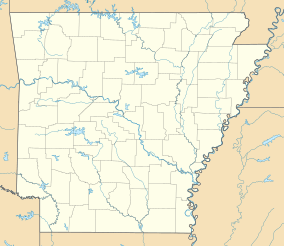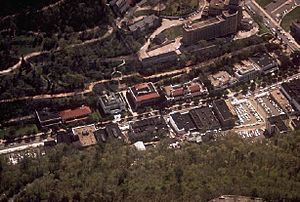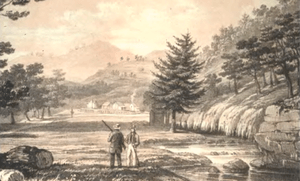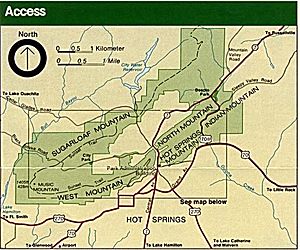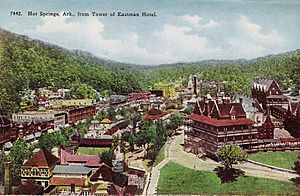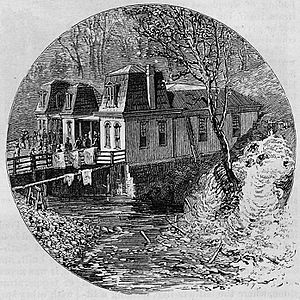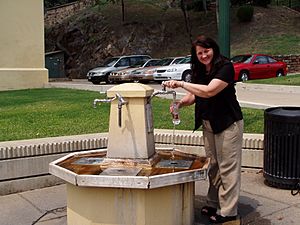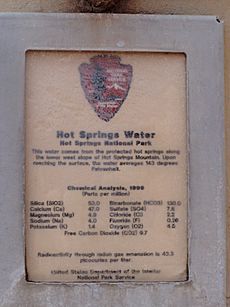Hot Springs National Park facts for kids
Quick facts for kids Hot Springs National Park |
|
|---|---|
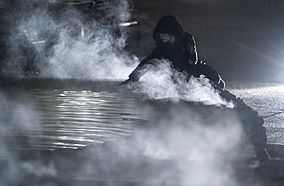
Hot spring pool steaming at the entrance of the park
|
|
| Location | Garland County, Arkansas, United States |
| Nearest city | Hot Springs |
| Area | 5,550 acres (22.5 km2) |
| Established | April 20, 1832 (designated as a national park on March 4, 1921) |
| Visitors | 1,506,887 (in 2018) |
| Website | Hot Springs National Park |
Hot Springs National Park is a special place in Garland County, Arkansas, right next to the city of Hot Springs. It's known for its amazing natural hot springs!
This park is unique because it was protected by the United States government way back on April 20, 1832. This was even before the idea of "national parks" existed! It was the first time the government set aside land just for people to enjoy and relax. For thousands of years, Native American tribes believed the hot spring water had special healing powers. Because of this protection, the city of Hot Springs grew into a popular place for people to visit spas.
The area officially became a national park on March 4, 1921. For a long time, Hot Springs was the smallest national park in the United States. It was also the first national park to be featured on its own US quarter coin in 2010.
The hot springs flow from the side of Hot Springs Mountain, which is part of the Ouachita Mountain range. The park carefully manages these springs to make sure the clean hot water is available for everyone to use. The mountains in the park are also protected to keep the water system working properly.
People have used these hot springs for over 8,000 years, starting with Native American tribes. For more than 200 years, people have used the hot water in special baths to help with different health issues. This area became a famous resort called "The American Spa," attracting visitors from all over the world.
The park is very easy to visit because parts of it are right in downtown Hot Springs. You can find many hiking trails and places to camp. If you want to bathe in the spring water, you can do so at special facilities for an extra cost. The famous Bathhouse Row is a National Historic Landmark District. It has many beautiful old bathhouses, showing off amazing Gilded Age architecture. The Fordyce Bathhouse is now the park's visitor center. Only a few bathhouses, like the Buckstaff and Quapaw, still offer baths today. Other buildings on the row are being fixed up or used for other things.
Contents
- Discovering and Protecting the Hot Springs
- Becoming a National Park
- The City of Hot Springs
- Bathing in the Hot Springs
- Bathhouses You Can Pay For
- Army and Navy Hospital
- Disasters in Hot Springs
- Free Baths for Everyone
- Climate and Weather
- Plants and Animals
- How the Hot Springs Work: Geology
- What's in the Water?
- Images for kids
- See also
Discovering and Protecting the Hot Springs
For thousands of years, many Native American tribes visited this area. They called it the "Valley of the Vapors." The first European to see the springs was a Spanish explorer named Hernando de Soto in 1541. Native American tribes had been coming to the valley for over 8,000 years to enjoy the healing waters. Around the 1700s, the Caddo people lived here, followed by the Choctaw, Cherokee, and other tribes. These tribes agreed to put aside their weapons and share the healing waters in peace while in the valley. The Quapaw people, who lived nearby, also visited the springs.
In 1673, explorers Father Marquette and Jolliet explored the area and claimed it for France. Later, the land was given back to Spain, then returned to France, and finally became part of the United States with the Louisiana Purchase in 1803.
In 1804, President Thomas Jefferson sent explorers William Dunbar and George Hunter to study the area. They found only a few simple shelters used by people visiting the springs. In 1807, Jean Emmanual Prudhomme became the first European-American to settle in modern Hot Springs. He felt much better after bathing in the hot water for two years. Soon after, more cabins were built for visitors.
In 1818, the Quapaw Indians gave the land around the hot springs to the United States. In 1820, the Arkansas government asked for the springs and mountains to be protected by the federal government. Twelve years later, in 1832, the U.S. Congress officially protected the thermal waters. This made Hot Springs the very first area in the country to be set aside for federal protection. The Hot Springs Reservation was officially opened for public use as a park on June 16, 1880.
Becoming a National Park

In 1921, Congress changed the name from Hot Springs Reservation to Hot Springs National Park. The government bought more land, making the park bigger. It grew to include Hot Springs Mountain, North Mountain, West Mountain, Sugarloaf Mountain, and Whittington Lake Park. Eventually, the park became over 5,000 acres!
The hot springs are located at the base of Hot Springs Mountain. More than half a million gallons of hot water flow out each day! This hot water is sent to the different bathhouses, and the money from these services helps the U.S. Treasury. The park also has many miles of roads and trails for exploring the mountains. It is open all year round.
The very first bathhouses were simple huts built over holes in the rocks where the hot water collected. Later, people built more complex bathing places with wooden pipes that brought water from the hillside springs to bathhouses along Hot Springs Creek. After the government started managing the area in 1877, many improvements were made. The creek was covered, and a wide street was built over it. A new plumbing system was also put in place. By 1950, central cooling towers were added to make sure the water was always a safe temperature for bathers.
The park also has a public campground called Gulpha Gorge, which is about 2 miles (3 km) from downtown Hot Springs.
The City of Hot Springs
The city of Hot Springs, which started in 1851, is separate from the national park. The National Park Service does not control anything in the city. The city begins on the other side of Central Avenue from Bathhouse Row. It has grown beyond the narrow valley where the springs are, spreading out over the flat land to the south and east. The weather is pleasant all year. The city is about 600 feet (183 meters) above sea level, with hills around it rising another 600 feet (183 meters). In the past, the city was mostly a summer resort, but now hotels stay open all winter because many people from colder places come to escape the cold.
When the hot springs were most popular, many visitors would stay for weeks or even months. This brought a lot of business to the hotels, doctors, and shops in the town. Since the bathing treatments only took an hour or two each day, visitors had plenty of free time to enjoy other activities in the city.
Bathing in the Hot Springs
People believed the hot spring waters could help with many health problems. The earliest way to bathe was simply to lie in the natural pools of hot spring water mixed with cool creek water. In the 1820s, simple steam baths were built over the springs, and people would breathe in the steam. Wooden tubs were added to some bathhouses in the 1830s. Doctors started arriving in the 1850s, and visitors would stay for one week to two months. After the Civil War, a 15 to 20-minute tub bath became common.
By the 1870s, there were more types of baths, and doctors would suggest different ones for their patients. Tub baths became shorter, lasting only six to ten minutes, and steam baths were just two minutes. People usually took one bath a day.
The treatment involved drinking and bathing in the waters to make you sweat a lot. This sweating was thought to help fight sickness. It was important to get advice from a doctor who knew about the waters to avoid any problems.
Hot baths were usually taken once a day for three weeks. Then, people would take a break, sometimes visiting other springs. After the break, they would take another three-week course of baths. Most visitors stayed for one to three months, but some stayed even longer.
In 1878, a typical bath involved a hot bath (90-95°F or 32-35°C) for about 3 minutes. Then, you would sit in a steam box for another three minutes, drinking hot water. After this, you would be dried off and quickly walk back to your room to rest for at least half an hour.
Around 1884, bathhouses started using vapor cabinets. People would sit in these cabinets for 10-20 minutes, with hot vapor rising around them at temperatures up to 130°F (54°C). By the late 1800s, Russian and Turkish baths were offered, and later, German needle baths and Scotch douches (strong streams of hot or cold water) were added.
The park's superintendent set rules for the bathhouses. In the 1930s, a tub bath couldn't be longer than 20 minutes, and a shower no more than 90 seconds. Today, modern facilities offer spa-style services and pools.
Bathhouses You Can Pay For
At one point, almost two dozen bathhouses were open at the same time, with about nine of them on the famous "Bathhouse Row." Some bathhouses were even connected to hotels or hospitals. All bathhouses use the same water, but the prices changed based on the fancy equipment, rooms, and services they offered.
The area was very popular with baseball players in the early 1900s, and some teams even used it for spring training. In 1929, a single bath cost between $1 and $1.40, while a course of 21 baths cost $16 to $24. Until the 1960s, facilities were separated based on race.
Today, on Bathhouse Row, only the Buckstaff and Quapaw bathhouses are still open for bathing. The Fordyce Bathhouse is now the park's visitor center, and you can take tours to see how it looked historically. The Ozark Bathhouse is now a museum and can be rented for events. Other hotels in the city, like the Arlington Hotel, also offer hot spring baths using the park's water.
The Army and Navy General Hospital (now called the Rehabilitation Center) also received water from the hot springs. It was located behind Bathhouse Row. This hospital was for military members and veterans. The hot springs water was believed to be very helpful for their health. The hospital was for serious health problems that other treatments couldn't fix, but where the hot springs water was expected to help.
The building now known as the Hot Springs Rehabilitation Center was built in 1933. It has been used by the state for over 50 years and is a historic landmark.
Disasters in Hot Springs
Like many old cities, Hot Springs has faced fires and floods.
- In November 1864, during the American Civil War, a large part of the city burned down.
- On March 5, 1878, a big fire burned for eight hours, destroying almost 150 buildings, including hotels and bathhouses.
- On February 26, 1905, another fire started and burned 25 blocks of the southern part of the city.
- On September 5, 1913, a laundry worker accidentally started a fire that quickly spread due to strong winds, burning almost 60 blocks of the southern city.
The city has also had floods because it's in a narrow valley.
- On May 14, 1923, a heavy rainstorm caused water to rush down the mountains into Central Avenue, reaching a depth of nine feet (2.7 meters). Lightning also caused a fire that destroyed businesses.
- On February 15, 1956, a severe flood filled Central Avenue with three feet (0.9 meters) of rushing water, causing a lot of damage.
- On May 19, 1990, a series of storms dropped over 13 inches (330 mm) of rain, causing flash floods. A six-foot (1.8 meter) wave of water swept through downtown, causing huge damage, and a bridge was washed away.
More recently, on February 27, 2014, a fire broke out at the Majestic Hotel, just outside the park. It took many firefighters over 22 hours to put out the blaze, and the oldest part of the hotel was completely destroyed.
Free Baths for Everyone
In 1878, Congress created a free bathhouse for people who couldn't afford to pay. This first Government Free Bathhouse was a concrete building designed to bathe many people in a clean way. In 1916, a clinic was opened there to examine and treat people taking the free baths. About 100,000 baths were given to the poor each year. People who wanted a free bath had to promise they couldn't afford to pay for it. They were given tickets if a doctor thought the baths would help their health.
Over time, some of the open springs dried up or were covered to prevent pollution. A new free bathhouse was built in 1904, with separate areas for different groups of people. Another new bathhouse was built in 1922.
The Park Service reminded people that they needed to bring their own food, lodging, and money for travel home. This was because many poor people came, thinking they would be cared for for free. The free bathhouse closed in 1957. After that, the few people who couldn't pay were sent to commercial bathhouses, and the government paid for their baths.
Climate and Weather
Hot Springs National Park has a Humid subtropical climate. This means it has hot, humid summers and mild winters. The average lowest temperature in winter is about 9.5°F (-12.5°C).
| Climate data for Hot Springs National Park Visitor Center. Elev: 712 ft (217 m) | |||||||||||||
|---|---|---|---|---|---|---|---|---|---|---|---|---|---|
| Month | Jan | Feb | Mar | Apr | May | Jun | Jul | Aug | Sep | Oct | Nov | Dec | Year |
| Mean daily maximum °F (°C) | 51.4 (10.8) |
56.2 (13.4) |
64.7 (18.2) |
73.6 (23.1) |
80.5 (26.9) |
88.2 (31.2) |
92.9 (33.8) |
93.3 (34.1) |
85.7 (29.8) |
74.8 (23.8) |
62.9 (17.2) |
52.5 (11.4) |
73.1 (22.8) |
| Daily mean °F (°C) | 40.7 (4.8) |
44.6 (7.0) |
52.6 (11.4) |
61.3 (16.3) |
69.5 (20.8) |
77.1 (25.1) |
81.3 (27.4) |
80.9 (27.2) |
73.3 (22.9) |
62.4 (16.9) |
51.7 (10.9) |
42.1 (5.6) |
61.5 (16.4) |
| Mean daily minimum °F (°C) | 29.9 (−1.2) |
33.0 (0.6) |
40.5 (4.7) |
48.9 (9.4) |
58.4 (14.7) |
66.0 (18.9) |
69.7 (20.9) |
68.5 (20.3) |
60.9 (16.1) |
50.0 (10.0) |
40.6 (4.8) |
31.7 (−0.2) |
49.9 (9.9) |
| Average precipitation inches (mm) | 3.56 (90) |
4.13 (105) |
5.18 (132) |
5.01 (127) |
5.86 (149) |
4.40 (112) |
4.40 (112) |
2.81 (71) |
3.78 (96) |
5.31 (135) |
5.45 (138) |
5.14 (131) |
55.03 (1,398) |
| Average relative humidity (%) | 68.1 | 65.4 | 62.6 | 63.2 | 70.8 | 71.6 | 68.9 | 67.0 | 68.5 | 69.0 | 71.8 | 71.9 | 68.2 |
| Average dew point °F (°C) | 31.0 (−0.6) |
33.7 (0.9) |
40.2 (4.6) |
48.7 (9.3) |
59.6 (15.3) |
67.2 (19.6) |
70.1 (21.2) |
68.9 (20.5) |
62.3 (16.8) |
52.1 (11.2) |
42.9 (6.1) |
33.7 (0.9) |
50.9 (10.5) |
| Source: PRISM Climate Group | |||||||||||||
Plants and Animals
The area around Hot Springs is mostly forest. The northern sides of the hills and valleys have deciduous forests, which means trees like oak and hickory that lose their leaves in the fall. On the southern sides of the hills, you'll find more Pine trees. There are also areas of very old pine and oak forests, with some trees over 200 years old!
Animals like Plains bison, elk, cougars, and red wolfs used to live here but left after European settlers arrived. Today, you can see animals like white-tailed deer, wild turkey, squirrels, rabbits, Virginia opossums, gray foxes, coyotes, skunks, raccoons, gophers, long-tailed weasels, minks, rats, chipmunks, frogs, and nine-banded armadillos. Many migratory birds also visit the area as they travel along the Mississippi Flyway.
How the Hot Springs Work: Geology
The hot springs are located in the Ouachita Mountains of central Arkansas. The springs appear in a gap between Hot Springs Mountain and West Mountain. The hot water comes from thousands of feet underground and mixes with some cooler water from closer to the surface. There are 43 hot springs in the park that are believed to be flowing. Water from 33 of these springs is collected and sent to a central tank for public use. The rocks in the area include shale, which slows down water, and fractured chert, novaculite, and sandstone, which allow water to move through easily.
The water starts as rain that falls in the mountains to the north. It slowly moves downward through cracks in the rocks, about one foot (30 cm) per year. This rainwater goes very deep, sometimes 4,500 to 7,500 feet (1,370 to 2,286 meters) underground. There, it gets very hot from the natural heat of the Earth. Then, it rises back up along cracks and faults in the rocks. Some rainwater from near the surface also mixes with the deep hot water before it comes out. The journey down takes about 4,000 years, but the hot water only takes about a year to reach the surface.
The heat comes from the Earth's natural warmth as you go deeper underground. The water's makeup shows that it's heated rainwater, not from volcanoes. This results in slightly alkaline, good-tasting water with dissolved minerals.
Types of Rocks in the Park
The rocks you see near the hot springs are sedimentary rocks, which formed from layers of sediment over millions of years. These include shale, chert, novaculite, sandstone, and conglomerate. There are also some younger igneous rocks (formed from cooled lava) found in other areas nearby.
- The Stanley Shale is mostly black or green clay-like rock with layers of sandstone. Most of the low-lying areas in Hot Springs city are made of this shale.
- The Hot Springs Sandstone is a hard, gray sandstone with some shale and conglomerate.
- The Arkansas Novaculite is a very hard rock, mostly found on Hot Springs Mountain.
- Other rocks like Polk Creek Shale, Missouri Mountain Shale, Bigfork Chert, and Womble Shale are also present.
Millions of years ago, the area that is now the Ouachita Mountains was under a shallow sea, where many layers of sediment built up. About 500 million years ago, two large land plates collided. This caused the shale and sandstone layers to crack and fold, forming the mountains we see today. The hot springs come out from a large folded rock structure. Many cracks and fissures in the rocks allow the water to flow in the hot springs area. Minerals dissolved in the water create the white or tan "tufa rock" you can see near the springs.
What's in the Water?
The water in all the springs comes from the same deep source. In the past, different springs had different names based on how they looked or what minerals were thought to be in them, like "Mud Spring" or "Big Iron." Now, the water from many springs is combined into one supply. The park gets between 750,000 to 950,000 gallons (2.8 to 3.6 million liters) of hot water each day! The average temperature is about 143°F (62°C).
The water has a small amount of radioactivity from dissolved radon gas. Don't worry, the level of radiation from bathing is very low and considered safe, similar to sitting in the sun for the same amount of time. The park's water is well within safe limits and similar to other natural waters around the world.
You can drink the hot water from several public fountains. The hot water is naturally safe to drink. There are also two cold water springs (Happy Hollow and Whittington Springs) that are treated with ozone to make them safe. It's against the rules for private individuals to sell the park's water.
| Chemical | Parts per million |
|---|---|
| Bicarbonate (HCO3−) | 130.0 |
| Silica (SiO2) | 53.0 |
| Calcium (Ca2+) | 47.0 |
| Free carbon dioxide (CO2) | 9.7 |
| Sulfate (SO42−) | 7.8 |
| Oxygen (O2) | 4.5 |
| Magnesium (Mg2+) | 4.9 |
| Chloride (Cl−) | 2.2 |
| Sodium (Na+) | 4.0 |
| Potassium (K+) | 1.4 |
| Fluoride (F−) | 0.26 |
Images for kids
See also
 In Spanish: Parque nacional Hot Springs para niños
In Spanish: Parque nacional Hot Springs para niños


